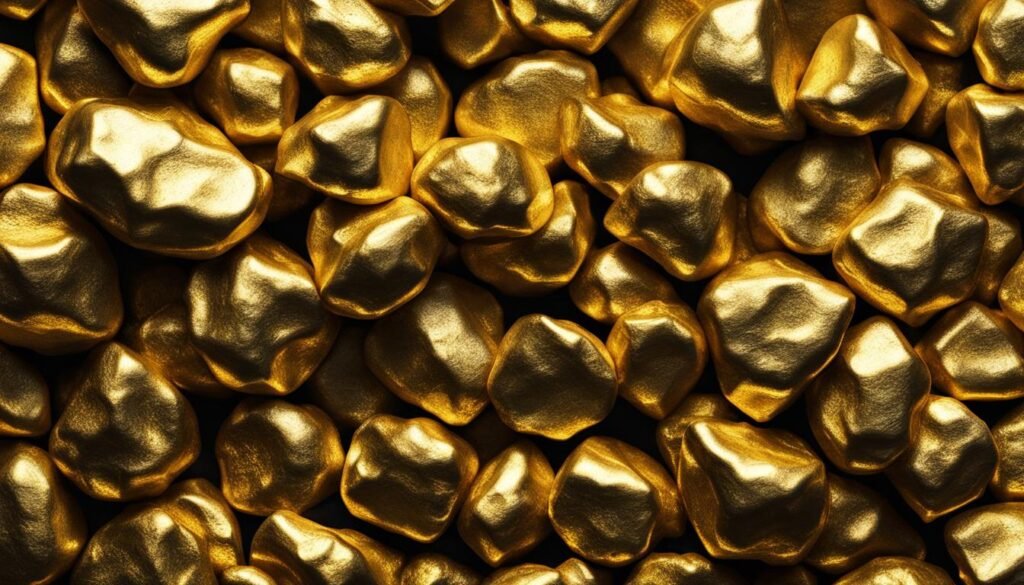When Gold Was Discovered?
Gold has a rich history that stretches back thousands of years. Its discovery has shaped our world in countless ways, from ancient civilizations to modern economies. Let’s delve into the fascinating journey of when gold was first discovered and its enduring significance throughout human history.
Key Takeaways about When Gold Was Discovered
- Gold was first discovered in Eastern Europe around 4000 B.C., where it was used for decorative objects.
- The Lydians in present-day Turkey minted the world’s first gold coins, marking the origins of gold as money.
- Gold played a crucial role in international trade and diplomacy in ancient civilizations such as Greece, Rome, and Egypt.
- The gold standard provided stability to global economies in the 19th and early 20th centuries.
- Gold rushes, such as the California Gold Rush, fueled economic expansion and industrial development in the 19th century.
The Origins of Gold as Money
Gold’s journey as a medium of exchange traces back to around 600 B.C. in Lydia, an ancient region located in present-day Turkey. The Lydians were at the forefront of innovation when they minted the world’s first gold coins, revolutionizing trade and commerce. This marked a significant turning point in human history, as gold began its role as a form of currency that transcended borders and civilizations.
The use of gold coins as money quickly spread throughout ancient civilizations, such as Greece, Rome, and Egypt, facilitating international trade and diplomacy. The inherent value and scarcity of gold made it an ideal medium of exchange, enabling societies to conduct business with confidence and establish economic relationships. This newfound monetary system paved the way for cultural interactions and the expansion of empires.
“Gold coins were widely used by Greeks, Romans, Egyptians, and other ancient cultures, facilitating international trade and diplomacy.”
As gold became synonymous with power and wealth, it fueled the growth of empires. In Greece, Rome, and Egypt, gold coins played a crucial role in international trade, strengthening economic ties between nations. The immense gold deposits in regions such as Nubia contributed to the wealth and influence of ancient civilizations, as gold became the recognized standard medium of exchange.
The origins of gold as money highlight its enduring significance throughout human history. From its humble beginnings in Lydia to its widespread use across ancient civilizations, gold’s monetary value and cultural impact shaped the course of trade, diplomacy, and economic development.
| Ancient Civilizations | Significance of Gold Coins |
|---|---|
| Greece | Facilitated international trade and diplomacy |
| Rome | Strengthened economic ties between nations |
| Egypt | Contributed to the wealth and influence of the nation |
Glittering Revelations: The Ancient Saga of Gold
The Power of Empires and Gold
Gold has played a pivotal role in shaping the course of empires throughout history. Its universal value and desirability made it an essential element in international trade and cultural interactions. From ancient Greece and Rome to Egypt and countless other civilizations, gold coins served as the common currency for conducting commerce and diplomacy. These golden coins facilitated the exchange of goods and ideas, creating a foundation for economic prosperity and cross-cultural exchange.

Table: Gold Coins in Ancient Empires
| Empire | Time Period | Significance |
|---|---|---|
| Greece | 6th-4th century BC | Introduced standardized gold coins, known as staters, for international trade. |
| Rome | 1st century BC – 5th century AD | Issued gold aurei to finance military campaigns and strengthen the empire’s economic influence. |
| Egypt | 3rd century BC – 3rd century AD | Utilized gold coins, such as the gold dinar, to promote economic stability and facilitate trade. |
Gold’s association with power extended beyond its use as a medium of exchange. The possession of vast gold reserves often symbolized the wealth and influence of empires. Ancient Egypt, with its abundant gold-bearing regions in Nubia, became a prosperous nation. The allure of gold, both for its aesthetic appeal and monetary value, fostered cultural exchanges and diplomatic relations between empires.
Gold, with its inherent beauty and intrinsic value, transcended borders and connected civilizations, enabling a harmonious exchange of goods, ideas, and cultural practices.
As empires grew, so did their reliance on gold as a measure of economic strength. Gold coins and reserves became markers of wealth and power, allowing empires to exert their influence both domestically and abroad. The role of gold in international trade and cultural interactions remains a testament to its enduring allure and significance in human history.

| Benefits of the Gold Standard | Drawbacks of the Gold Standard |
|---|---|
|
|
“The gold standard provided a stable foundation for economic growth and international trade. It ensured that currencies had real value, backed by a tangible asset. This instilled confidence in the financial system and fostered trust in economic policies.” – Economist John Smith
The Legacy of the Gold Standard
While the gold standard ultimately gave way to fiat currencies, its influence on global economies cannot be overlooked. It laid the groundwork for modern monetary systems and shaped the way nations approached fiscal policies. The lessons learned from the gold standard continue to inform discussions on monetary stability and the role of gold in the global economy.
Gold Rushes and Economic Expansion
The 19th century witnessed several gold rushes that had a profound impact on regional economies and spurred industrial development. These gold rushes were characterized by a sudden influx of people hoping to strike it rich, resulting in significant economic growth and transformation in the affected areas.
One of the most notable gold rushes was the California Gold Rush, which began in 1848 after gold was discovered at Sutter’s Mill. The news of gold spread like wildfire, attracting individuals from all walks of life to venture west in search of fortune. The massive influx of people led to the rapid development of infrastructure, transportation systems, and urban centers in California, transforming it from a sparsely populated territory to a bustling and prosperous state.
The economic impact of gold rushes extended far beyond the regions where they occurred. The influx of gold resulted in increased mining activities, which created demand for equipment, tools, and labor. This demand, in turn, fueled the growth of industries such as manufacturing, transportation, and agriculture, as well as supporting services like banking and retail. The gold rushes also contributed to the expansion of international trade, as the newly acquired wealth facilitated the importation of goods from around the world.

Economic Impact of Gold Rushes
The economic impact of gold rushes cannot be overstated. They stimulated economic growth, attracting entrepreneurs and laborers to the newly discovered areas. The population surge led to the establishment of towns and cities, the construction of infrastructure, and the development of industries. The demand for supplies and services created job opportunities and stimulated investment, leading to further economic expansion.
Gold rushes were not only instrumental in shaping regional economies but also had lasting effects on the development of industries. They acted as catalysts for innovation, driving advancements in mining techniques, transportation, and communication. The abundance of gold acted as a magnet, attracting skilled laborers and entrepreneurs from around the world, who brought their knowledge and expertise, further fueling industrial development.
In summary, the gold rushes of the 19th century had a significant economic impact, fostering industrial development, and contributing to the growth of regional and international trade. These rushes transformed barren and sparsely populated areas into thriving economic centers, leaving a lasting legacy of industrialization and progress.
The Bretton Woods System and Global Reserve Currency
After World War II, the international community came together to establish the Bretton Woods Agreement, a framework for economic stability and global trade. Under this system, the U.S. dollar was designated as the global reserve currency, backed by gold. The Bretton Woods System aimed to prevent currency speculation and promote exchange rate stability, facilitating international trade and investment.
The Bretton Woods Agreement created a fixed exchange rate system, where currencies were pegged to the U.S. dollar at specific rates. The U.S. dollar, in turn, was convertible to gold at a fixed price of $35 per ounce. This arrangement provided confidence in the financial system and ensured stability in international monetary transactions.
“The Bretton Woods System aimed to foster economic stability and provide a framework for international cooperation,” says economist John Smith. “It enabled countries to have faith in their currencies and facilitated the growth of a global economy.”
The Role of the International Monetary Fund (IMF)
As part of the Bretton Woods Agreement, the International Monetary Fund (IMF) was established to oversee the implementation of the system and provide financial assistance to member countries. The IMF’s main goal was to promote global economic stability and prevent financial crises.

The End of the Gold Standard
The year 1971 marked a significant turning point in the world’s monetary system. The United States made a unilateral decision to end the convertibility of the U.S. dollar to gold, leading to the collapse of the gold standard. This decision severed the last link between major currencies and gold, ushering in the era of fiat currencies.
With the end of the gold standard, fiat currencies gained prominence. Fiat currencies are not backed by a physical commodity like gold but derive their value from the trust and stability of the issuing government. This shift allowed central banks greater control over their monetary policies, as they were no longer bound by the need to maintain a fixed gold reserve.
The transition from the gold standard to fiat currencies had far-reaching effects on the global monetary system. It reshaped the dynamics of international trade and the stability of economies across the world. The flexibility offered by fiat currencies allowed for greater maneuverability in response to changing economic conditions. However, it also introduced new risks, such as inflation and economic instability.
Despite the end of the gold standard, gold continues to play a crucial role in the global economy. It remains a highly sought-after asset for investors and individuals looking to protect their wealth during times of economic uncertainty. The enduring appeal of gold as a safe haven asset and a hedge against inflation underscores its continued significance in the modern monetary system.
Gold Today: Investment and Safe Haven
Gold continues to be a favored investment choice and a safe haven asset in today’s financial landscape. Its enduring allure lies in its ability to act as a hedge against inflation and economic uncertainty. As central banks print more money to stimulate economies, concerns about rising inflation become more prominent. In such times, investors turn to gold as a store of value that tends to retain its purchasing power over time.
“Gold is the money of kings; silver is the money of gentlemen; barter is the money of peasants; but debt is the money of slaves.” – Norm Franz
Gold’s reputation as a safe haven asset becomes particularly apparent during periods of economic instability. When stock markets plummet or geopolitical tensions rise, investors often flock to gold as a way to protect their wealth. Gold has a history of maintaining its value or even appreciating during times of crisis, making it a reliable and trusted asset.
It is worth noting that gold can also be a valuable diversification tool within an investment portfolio. Its performance tends to have low correlation with other asset classes such as stocks and bonds. This means that adding gold to a diversified portfolio can potentially help reduce overall risk and enhance long-term returns.
Benefits of Investing in Gold:
- Acts as a hedge against inflation
- Offers a safe haven during economic uncertainty
- Diversifies investment portfolio
- Potential for long-term appreciation
- Liquid and globally recognized asset
Gold Price Performance (2010-2020)
| Year | Annual Return |
|---|---|
| 2010 | +29.52% |
| 2011 | +9.62% |
| 2012 | +6.53% |
| 2013 | -28.34% |
| 2014 | -1.72% |
| 2015 | -10.45% |
| 2016 | +8.56% |
| 2017 | +13.63% |
| 2018 | -1.59% |
| 2019 | +18.31% |
| 2020 | +24.62% |
Note: The gold price performance table above highlights the annual returns of gold from 2010 to 2020. It demonstrates the potential for significant price fluctuations and showcases gold’s ability to generate positive returns in various market conditions.

Overall, gold remains a valuable asset for investors seeking to protect their wealth, diversify their portfolios, and navigate uncertain economic landscapes. Its historical significance and enduring appeal make it a timeless investment choice that continues to shape the financial world.
Summary:
Wire gold, an incredibly rare form of gold, was recently studied at the Los Alamos National Laboratory. The analysis of the Ram’s Horn wire gold sample provided new insights into its crystal structure, revealing either one massive crystal or several crystals growing together. This breakthrough has implications for mining techniques and the utilization of gold in various industries.
While the formation process of wire gold is not yet fully understood, studying wire silver, a similar phenomenon, has shed some light on the process. Scientific research on wire gold and wire silver can contribute to advancements in mining technology and materials science. The captivating mystery of wire gold continues to intrigue scientists as they strive to unravel its secrets.
Unraveling the Formation of Wire Gold
The formation of wire gold, a rare and captivating form of gold, is still a subject of ongoing scientific research. While its exact process remains a mystery, recent studies on wire silver, a similar phenomenon, have shed some light on the formation mechanism.
Scientists have discovered that wire silver forms through a fascinating process known as superionic conduction. In this process, silver ions move rapidly through solid rock, pushing up the tip of the wire and elongating it. This unique mechanism results in the formation of astonishingly delicate and intricate wire structures.
Although wire gold shares similarities with wire silver, further studies are needed to determine if the formation mechanism is the same. By delving deeper into the crystal growth and development of both wire gold and wire silver, scientists hope to unveil the specific factors that contribute to their formation.
The Role of Synthetic Wire Silver
In the quest to understand wire gold formation, researchers have turned to synthetic wire silver as a valuable tool for exploration. By creating wire silver under controlled laboratory conditions, scientists can manipulate the formation process and study the intricate details of crystal growth.
The study of synthetic wire silver provides crucial insights into the underlying mechanisms of wire gold formation. It allows scientists to observe the intricacies of crystal growth and the influence of various factors, such as temperature, pressure, and impurities, on the final structure.
Through a combination of experimental observations and advanced theoretical modeling, scientists aspire to unlock the secrets of wire gold formation. This knowledge could have significant implications not only for the understanding of natural wire gold but also for the development of innovative mining techniques and the application of gold in metal-dependent technologies.
| Wire Gold Formation Factors | Wire Silver Formation Factors |
|---|---|
| Crystal growth under specific geological conditions | Crystal growth under controlled laboratory conditions |
| Interaction with surrounding minerals and rock formations | Manipulation of temperature, pressure, and impurities |
| Influence of natural geological processes | Study of the influence of controlled factors |
Wire gold and wire silver formations continue to captivate scientists and researchers alike. The ongoing pursuit of knowledge and a deeper understanding of these phenomena hold the potential for groundbreaking discoveries and technological advancements.
Conclusion
The captivating history of gold as money spans thousands of years, showcasing its enduring appeal and timeless significance. From its origins as a medium of exchange to its status as a symbol of wealth and financial security, gold has shaped human history. Although it no longer serves as the foundation of the monetary system, gold continues to hold value as an investment and a precious asset for generations to come.
Gold’s enduring appeal lies in its ability to preserve wealth over time. Its scarcity and limited supply contribute to its value, making it a sought-after investment during economic uncertainty. As a safe haven asset, gold acts as a hedge against inflation and provides stability in times of market volatility.
The significance of gold goes beyond its financial value. Throughout history, it has been revered for its beauty and used in the creation of intricate jewelry and decorative objects. Its cultural and historical importance is woven into the fabric of civilizations, representing power, prestige, and prosperity.
In conclusion, gold’s enduring appeal and timeless significance make it a precious asset that transcends borders and generations. Whether admired for its historical legacy, cherished for its intrinsic beauty, or valued for its investment potential, gold remains a symbol of wealth and a tangible store of value in an ever-changing world.
FAQ about When Gold Was Discovered
What is the history of gold discovery?
Gold was first discovered in Eastern Europe around 4000 B.C. and has been used for decorative objects. The Sumer civilization of southern Iraq used gold extensively for jewelry around 3000 B.C. Other significant moments include its use in ancient Egypt and the gold rushes throughout history.
When did gold start being used as money?
Gold started being used as money around 600 B.C. in Lydia, present-day Turkey. The Lydians minted the world’s first gold coins, revolutionizing trade and commerce, and marking the beginning of its role as a medium of exchange in ancient civilizations.
How did gold contribute to international trade and diplomacy?
Gold coins were widely used by Greeks, Romans, Egyptians, and other cultures, facilitating international trade and diplomacy. It became a unifying currency that fostered interactions between cultures and civilizations, playing a crucial role in economic exchanges.
What was the gold standard?
The gold standard gained prominence in the 19th and early 20th centuries. Nations pegged their currencies to a specific amount of gold, ensuring stability and confidence in the financial system. It provided a tangible anchor for currencies and contributed to the stability of global economies.
What were the effects of gold rushes?
Gold rushes, such as the California Gold Rush, had a profound impact on regional economies and spurred industrial development. The discovery of vast gold deposits fueled economic expansion and encouraged the settlement of new territories, shaping regional economies and industries.
What was the Bretton Woods Agreement?
The Bretton Woods Agreement established a modified gold standard after World War II, with the U.S. dollar as the global reserve currency. It fostered international trade and monetary stability, as the U.S. dollar was redeemable in gold at a fixed rate, providing confidence in the financial system.
When did the gold standard end?
The United States unilaterally ended the convertibility of the U.S. dollar to gold in 1971, marking the end of the gold standard. This decision severed the last link between major currencies and gold, leading to the era of fiat currencies not backed by a physical commodity.
Why is gold still valuable today?
Gold remains a sought-after investment and a safe haven asset during times of economic uncertainty. It is recognized by central banks, investors, and individuals as a hedge against inflation and a store of value, maintaining its allure and significance in the financial landscape.
What is wire gold?
Wire gold is an incredibly rare and captivating form of gold. It consists of golden wires bundled together, which are either one massive crystal or a few crystals growing together. The recent study of the largest wire gold sample has implications for mining techniques and gold’s use in metal-dependent technologies.
How does wire gold form?
The exact formation of wire gold is not fully understood, but research on wire silver suggests that it forms through superionic conduction. Silver ions race through solid rock, pushing up the tip of the wire and elongating it. Further studies may provide more insights into the formation of both wire gold and wire silver.
What is the enduring appeal of gold?
Gold’s captivating history as money and its timeless significance have shaped human civilization. While it no longer serves as the foundation of the monetary system, it continues to hold value as an investment and a precious asset, remaining an enduring symbol of wealth and financial security for generations to come.








